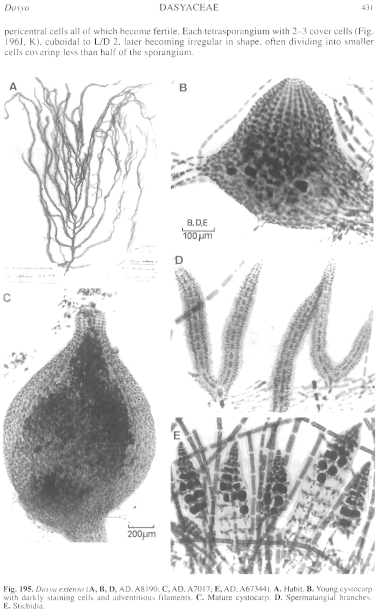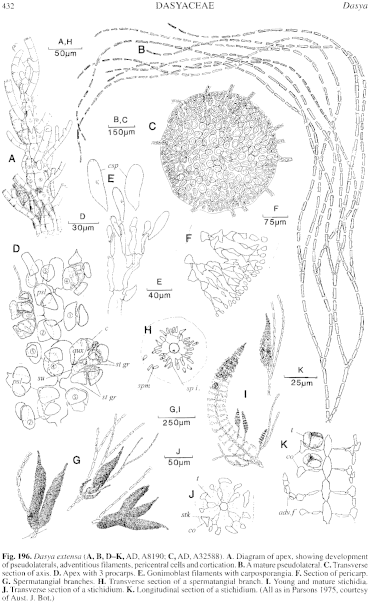|
|
|
|
|
|||||||||||
|
Electronic Flora of South Australia Species Fact Sheet
Phylum Rhodophyta – Order Ceramiales – Family Dasyaceae
Selected citations: Fuhrer et al. 1981 : pls 71, 72. Huisman & Walker 1990: 42. Parsons 1975: 569, figs 2–4, 39B. Silva et al. 1996: 435.
Synonyms
Dasya villosa sensu Harvey 1844: 433, in part (see Parsons 1975, p. 568). J. Agardh 1890a: 103, in part. Lucas & Perrin 1947: fig. 150. Reinbold 1898: 50. Womersley 1966: 152.
Dasya villosa var. macroura Harvey 1863, synop.: xxii. Wilson 1892: 165. [Lectotype selected here: "W. Australia, G. C(lifton)" TCD. Isolectotype in Herb. Hooker, BM].
Nematophora australis J. Agardh 1890a: 35, pl. 1 fig. 3. De Toni 1924:
Thallus (Fig. 195A) pale to dark red, occasionally brown-red, mucilaginous, 10–130 cm high, with 1–10 corticated erect axes 2–6 mm in diameter. Main axes irregularly branched with few to many long, linear, laterals, which may carry further lateral branches, densely clothed throughout with rhodoplastic, unbranched or basally branched, slender, attenuate monosiphonous filaments. Holdfast discoid, 3–6 mm in diameter or an expanded, tuberculate, cartilaginous perennating base up to 25 mm across; epilithic or epiphytic. Structure. Pericentral cells 5, heavily corticated with rhizoidal filaments and not apparent in transverse sections of a mature axis (Fig. 196C). Pseudolaterals (Fig. 196B) one on each segment (Fig. 196A), 1–6 mm long, slightly attenuate, usually subdichotomous every (1–) 4–9 (–18) cells near their base with (1–) 3–4 (–5) subdichotomies on any filament giving 8–20 ultimate branches, basal cells 30–45 in diameter and L/D 0.5–1, cells of ultimate filaments (10–) 20–35 µm in diameter and L/D (2–) 2.5–6 (–9). Adventitious monosiphonous filaments arise from the upper ends of both the pericentral cells and cortical cells, unbranched or basally subdichotomous 1–3 times like the pseudolaterals. Intercalary cell divisions may occur in any part of the monosiphonous filaments. Lateral branches arising from the first or second branch of an adventitious monosiphonous filament. Rhodoplasts discoid to elongate, becoming chained and reticulate.
Reproduction: Gametophytes dioecious. Procarps borne spirally on short, polysiphonous, adventitious axes formed irregularly over the thallus, with 4-celled carpogonial branches (Fig. 196D). Carposporophytes with a slight basal fusion cell, much branched with ovoid to clavate, apical and lateral carposporangia (Fig. 196E) not in rows. Cystocarps (Fig. 195B, C) almost sessile on an axis, or terminal but lateral on a corticated stalk up to 2.5 mm long, sometimes with extruding monosiphonous filaments, urceolate, 700–1600 µm in diameter, with a short neck less than 1/4 the diameter of the cystocarp in length; pericarp (Fig. 196F) 4–6 cells thick, outer cells small. Spermatangial branches (Figs 195D, 196G) sessile or on a monosiphonous stalk 1–2 cells long, on the lower branches of monosiphonous filaments, lanceoid to cylindrical, occasionally branched and rarely with accessory spermatangial branches, 350–650 µm long and 75–90 pan in diameter (Fig. 196H), with 10–25 fertile segments, terminating with a 1–5 celled filament.
Stichidia (Figs 195E, 196 I) on a 1–3-celled monosiphonous stalk, on the lower branches of the monosiphonous filaments, rarely with accessory stichidia near their base, lanceoid to cylindrical, 300–1000 µm long and 90–130 µm in diameter, with 15–35 fertile segments of 5 pericentral cells all of which become fertile. Each tetrasporangium with 2–3 cover cells (Fig. 196J, K), cuboidal to L/D 2, later becoming irregular in shape, often dividing into smaller cells covering less than half of the sporangium.
Type from Lefevre Pen., S. Aust. (Mueller 24, 16.xii.1847); lectotype in MEL, 1006628, tetrasporangial (see Parsons 1975, p. 569). Isolectotypes in MEL, 1005816, 1005817, 1005818, L, 940,347...242.
Selected specimens: South Beach, Dongara, W. Aust.. drift (10.ii.1944; UWA, A842). Safety Bay, W. Aust. (Smith, May 1943; UWA, A841 ). Flinders Bay, W. Aust., drift (Wollaston, 12.0.1957; AD, A22112). Hopetoun, W. Aust., drift (Parsons, 20.xi.1968; AD, A33361 -"Marine Algae of southern Australia" No. 112b). Head of Great Australian Bight, S. Aust., drift (Parsons, 4.xi.1968; AD, A34396 -"Marine Algae of southern Australia" No. 112a). Point Sinclair, S. Aust., drift (Womersley, 7.ii.1954; AD, A19575). Elliston Bay, S.Aust., 6–10 m deep (Shepherd &Turner, 30.iv.1982; AD, A53135). N Spencer Gulf, S. Aust., 9 na deep (Shepherd, 13.ix.1973; AD, A44190). Chinaman Hat I. Bay, Yorke Pen., S. Aust., drift (Woelkerling, 22.ix.1968; AD, A32588). Investigator Strait, S.Aust., 31 m deep (Watson, 23.i.1971; AD, A41119). 3.2 km SE of Troubridge 1., S. Aust., 24 m deep (Shepherd, 5.i i.1969; AD, A33898). Brighton, S. Aust., drift (Bienert, 12.xi.1965; AD, A29668). Vivonne Bay, Kangaroo I., S. Aust., 3–4 m deep on jetty piles (Latz, 22.xi.1968; AD, A33022). Pennington Bay, Kangaroo I., S. Aust., drift (Womersley, 4.i.1948; AD, A7017). Picnic Point, American R. Inlet, Kangaroo I., S. Aust., 2 m deep (Womersley, 23.i.1948; AD, A8190). NE of Ballast Head, Kangaroo I., S. Aust., 12 m deep (Hone, 13.ii.1997; AD, A66935). Blackfellows Caves, SE S.Aust., drift (Hotchkiss, 3.xi.1997; AD, A67344). Port Phillip, Vic. (Mueller, Oct. 1879; MEL, 1005829). South Melbourne, Vic. (Bastow, 23.x.1896; MEL, 608744, with small tuberculate base). Walkerville, Vic., drift (Sinkora A2157, 7.iii.1975; AD, A48288). Bombay Rock, Tamar Est., Tas. (F. &; G. Perrin, April 1949; AD, A48208). Beauty Point, Tamar Est., Tas., upper sublittoral on barge (Wollaston & Mitchell, 5.iii.1964; AD, A28021).
Distribution: Dongara, W. Aust., to Walkerville, Vic., and the N coast of Tasmania.
Taxonomic notes: The perennating base of D. extensa is closely appressed to the substrate, with large, rather rounded, cartilaginous tubercules (3–8 mm in diameter, 2–5 mm high) on its upper surface. An erect axis, often slightly constricted at its point of attachment, arises from the top of each tubercule. The constricted point of attachment of the axis to the tubercule is a point of weakness where the frond is more easily removed from the crustose base. Probably a new axis is formed from each tubercule the following season. Many of the more robust fronds of D. extensa, lacking a holdfast, were collected in the drift. These have a truncate base to the axis where they have been detached from the tuberculate perennial base. Further details on the morphology of D. extensa are given by Parsons (1975, pp. 571–578).
Nematophora australis J. Agardh (1890a, p. 35, pl. 1 fig. 3) from "Nov. Holl. (type in Herb. Agardh, LD, 27573) is a denuded plant of D. extensa, with a typical transverse section, monosiphonous filaments and young stichidia.
References:
AGARDH, J.G. (1890a). Till algernes systematik. Acta Univ. lund. 26(3), 1–125, Plates 1–3.
DE TONI, G.B. (1924). Sylloge Algarum omnium hucusque Cognitarum. Vol. 6. Florideae. (Padua.)
FUHRER, B., CHRISTIANSON, I.G., CLAYTON, M.N. & ALLENDER, B.M. (1981). Seaweeds of Australia. (Reed: Frenchs Forest, Sydney.)
HARVEY, W.H. (1844). Algae of Tasmania. Lond. J. Bot. 3, 428–454.
HARVEY, W.H. (1863). Phycologia Australica. Vol. 5, Plates 241–300, synop., pp. i-lxxiii. (Reeve: London.)
HUISMAN, J.M. & WALKER, D.I. (1990). A catalogue of the marine plants of Rottnest Island, Western Australia, with notes on their distribution and biogeography. Kingia 1, 349–459.
KÜTZING, F.T. (1864). Tabulae Phycologicae. Vol. 14. (Nordhausen.)
LUCAS, A.H.S. & PERRIN, F. (1947). The Seaweeds of South Australia. Part 2. The Red Seaweeds. (Govt Printer: Adelaide.)
PARSONS, M.J. (1975). Morphology and taxonomy of the Dasyaceae and Lophothalieae (Rhodomelaceae) of the Rhodophyta. Aust. J. Bot. 23(4), 549–713.
REINBOLD, T. (1898). Die Algen der Lacepede und Guichen Bay (Slid Australien) und deren näherer Umgebung, gesammelt von Dr. A. Engelhart-Kingston. II. Nuova Notarisia 9, 33–54.
SILVA, P.C., BASSON, P.W. & MOE, R.L. (1996). Catalogue of the Benthic Marine Algae of the Indian Ocean. (University of California Press: Berkeley, Los Angeles & London.)
WILSON, J.B. (1892). Catalogue of algae collected at or near Port Phillip Heads and Western Port. Proc. R. Soc. Vict. 4, 157–190.
WOMERSLEY, H.B.S. (1966). Port Phillip survey, 1957–1963: Algae. Mem. natn. Mus., Vict. No. 27, 133–156.
The Marine Benthic Flora of Southern Australia Part IIIC complete list of references.
Publication:
Womersley, H.B.S. (24 December, 1998)
The Marine Benthic Flora of Southern Australia
Rhodophyta. Part IIIC. Ceramiales – Ceramiaceae, Dasyaceae
©State Herbarium of South Australia, Government of South Australia
Illustrations in Womersley Part IIIA, 1998: FIGS 195, 196.

Figure 195 enlarge
Fig. 195. Dasya extensa (A, B, D, AD, A8190; C, AD, A7017; E, AD, A67344). A. Habit. B. Young cystocarp with darkly staining cells and adventitious filaments. C. Mature cystocarp. D. Spermatangial branches. E. Stichidia.

Figure 196 enlarge
Fig. 196. Dasya extensa (A, B, D–K, AD, A8190; C, AD, A32588). A. Diagram of apex, showing development of pseudolaterals, adventitious filaments, pericentral cells and cortication. B. A mature pseudolateral. C. Transverse section of axis. D. Apex with 3 procarps. E. Gonimoblast filaments with carposporangia. F. Section of pericarp. G. Spermatangial branches. H. Transverse section of a spermatangial branch. I. Young and mature stichidia. J. Transverse section of a stichidium. K. Longitudinal section of a stichidium. (All as in Parsons 1975, courtesy of Aust. J. Bot.)

|
Email Contact: State Herbarium of South Australia |

|